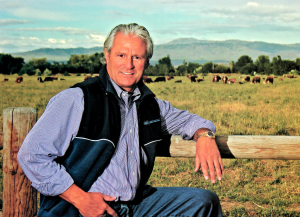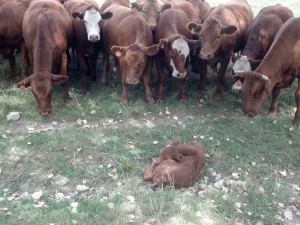Ron Sali
Ron grew up in the Moxee Valley of central Washington near the Yakima River. As a boy he worked on his family’s hop farm; it was a small operation that inspired to him to start his own. When Ron was 14, he saved up his money and bought his first cow and calf, marking his future as a rancher. After graduating and marrying his high school sweetheart, Ron started his own hop farm in Moxee. While he loved this life, eventually he realized his business needed to grow. There was little expansion opportunity for him in Washington–the hop market was just too crowded. In 1976, Ron took his first tour of the Idaho hop areas in Wilder. He loved the area and decided that it was where he wanted to be.
 Two years later in 1978, Ron moved to Wilder with some hop contracts of his own. After buying his land and building a house, he started his hop farm there. Over the first year, Ron began working with the University of Idaho experiment station, with funding from the Hop Growers of Idaho, to help grow a new variety of hops. He was the only one that offered to grow the new variety under commercial conditions at his own expense. The plan was that he would receive half of the root stock and the other half would go to other Idaho growers.
Two years later in 1978, Ron moved to Wilder with some hop contracts of his own. After buying his land and building a house, he started his hop farm there. Over the first year, Ron began working with the University of Idaho experiment station, with funding from the Hop Growers of Idaho, to help grow a new variety of hops. He was the only one that offered to grow the new variety under commercial conditions at his own expense. The plan was that he would receive half of the root stock and the other half would go to other Idaho growers.
Two of the new varieties were a huge success and began a bidding war between Anhaeuser-Bush and Miller Brewing Company over who would contract to purchase Ron’s crop. He ended up contracting for several hundred thousand pounds with multi year contracts. This was his first big stake and would allow him to follow other ventures in the future. Ron sold the operation at the peak of the market in 1981. It was at this point he decided to move to Boise and pursue other ventures.
 Ron began to study tax law, investment, and real estate during the early 80’s and became involved with many different local organizations. In 1986, during dinner with several local cattle ranchers at the Arid Club, Ron was asked to help brand and vaccinate cattle being shipped into a ranch in New Meadows Idaho. After returning from the trip, his passion for nature and ranching was renewed, and he decided that he wanted to get back to his roots. In 1989, he bought the 240 acres that would become Three Rivers Ranch. He recognized the value of being on the Boise River and saw that most people would learn to appreciate the wildlife and nature that exists along the riparian areas of the Boise River. The property had been neglected and mismanaged for several years prior to Ron’s purchase. Over a number of years Ron developed the property into a very efficient ranching operation. It was during this process that he became introduced into the sand and gravel industry.
Ron began to study tax law, investment, and real estate during the early 80’s and became involved with many different local organizations. In 1986, during dinner with several local cattle ranchers at the Arid Club, Ron was asked to help brand and vaccinate cattle being shipped into a ranch in New Meadows Idaho. After returning from the trip, his passion for nature and ranching was renewed, and he decided that he wanted to get back to his roots. In 1989, he bought the 240 acres that would become Three Rivers Ranch. He recognized the value of being on the Boise River and saw that most people would learn to appreciate the wildlife and nature that exists along the riparian areas of the Boise River. The property had been neglected and mismanaged for several years prior to Ron’s purchase. Over a number of years Ron developed the property into a very efficient ranching operation. It was during this process that he became introduced into the sand and gravel industry.
The ranch had very inefficient irrigation system so Ron took on the project of adding in a new, bigger irrigation system to the land. To do this he needed large volumes of water, so he contracted someone to come in and build a reservoir so he could pump large amounts of water for the ranch and being along the Boise River he knew there would be gravel. This became the beginning of a long career in sand and gravel mining.
Ron realized that building this pond was a great opportunity to make something more out of the construction of his ranch. They spent the next 16 years mining aggregate from the property; they were the largest producer of aggregate materials in the Valley for years and many of his materials went into building the local roads, commercial and residential developments and schools the surrounding area. In 2006 Ron built his home on the ranch and completed his 30 year plan to create Three Rivers Ranch.
Three Rivers Ranch is Ron’s passion, and he has put years into making sure the natural environment of the area was protected during his development. Three Rivers is truly different, and the difference begins with Ron. With his years of experience in farming, nature, and natural conservation, Ron put everything he had into the project to make it as natural and sustainable for fish and wildlife as possible.
At first blush, it appears that sand and gravel mining and environmental conservation are completely incompatible. Everyone has seen the large, open gravel pits that pock the landscape. Usually, sand and gravel mining has been viewed as irretrievably contrary to environmentalism, and, generally, this traditional view holds true. Sand and gravel are two of the main ingredients of infrastructure–a necessary evil, for lack of a better term.
The dig, strip, and abandon philosophy of gravel mining was not part of his development plan. Whereas most in the industry see choosing between gravel and home development as mutually exclusive, Ron literally developed the property “from the underground” up, starting with the extraction of necessary gravel and finishing with the most beautiful river and private lakefront property in the valley.
What makes his properties so unique is the focus on space for wildlife first, the space for people is secondary. To do this, Ron included lakes for fish and water-fowl and riparian areas for many other species of birds and animals. Every plant that is chosen for the development has a function to provide some sort of habitat for fish and wildlife, whether it is for shelter or a food source. Everything planted has function in addition to aesthetics. After nature was taken care of, Ron worked on how to make people fit into the natural areas.
All of Ron’s properties, including the nearby Moon Lake Ranch, are one of a kind. He has made sure that the area will forever be a safe home for wildlife and those who wish to live among it. Ron continues to make improvements to his business and actively participates in local boards and organizations like St Luke’s and the Girls and Boys Club of America.
Learn more about Ron’s current lifestyle and view pictures from the ranch.

